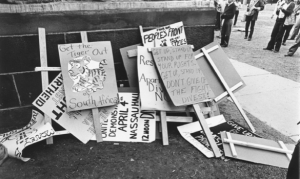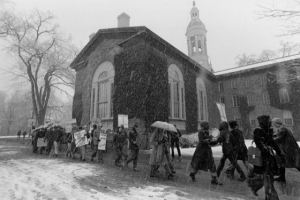
When the grand jury’s decision not to indict Officer Darren Wilson was broadcasted live on Monday night, the only television with sound in Frist Campus Center aired a football game. (I didn’t even think to change the channel.) I remember not being surprised. Apathy is Princeton University’s default setting, and our lack of campus protest is thus not surprising. The thinking goes: Princeton students don’t care. We are tone deaf at best in our Best Damn Place of All, and the most we can do is write about it in campus alt weeklies and our Twitter feeds. Princeton students don’t protest. Princeton students don’t make noise.
But on Monday we did. Where there would have normally been the sound of dull bass heard softly through brick, students instead yelled “No Justice! No Peace!” / “Hands Up! Don’t Shoot.” Banging pots and holding their hands above their heads, Princeton students marched on Monday, November 24th to protest the grand jury’s decision, protesting in solidarity with the citizens of Ferguson and celebrating Mike Brown’s life. Through the work of the march’s coordinators, Facebook groups and emails to listservs, students heeded the call and stormed the Street, displacing the night’s normal partygoers and allowing Princeton’s collective rage and fervor to pierce through.
In the hours after the Prospect March for Ferguson, Princeton stayed shook up. I ran into people on my way back to my dorm, people who, like me, couldn’t resume their nights the way they had assumed they would end them. We had never seen Princeton students engage in the world beyond our campus the way we did, and it thrilled us. This action seemed to promise more action, or at least a change in our culture.
Although the march was the most visible sign of it, this change in campus activism has been building for some time. The Prospect March reflects not only the passion and anger of students against a deeply flawed justice system, but also the growing nature of physical protest, of demonstration, and of change at Princeton University’s campus.
While perhaps the most visceral, the Prospect March was one among many student demonstrations this semester. On November 7th, students mocked posters advertising the event “Gay Marriage? A Debate” by posting up alternative signs (some highlights: “Straight People? A Debate,” and “Bears? A Debate.”) On November 8th, the consent awareness group SpeakOut chalked the foot of the stairway in front of 1879 arch with the message “SILENCE ≠ CONSENT / SPEAK OUT!” On November 11th, the Princeton campus organized in solidarity with Ferguson and participated in a lie-in, chalking the outlines of participants who lied on the ground as if shot. On November 12th, the entrance of TI (technically not a University-owned building) was marked with graffiti condemning the club as a “RAPE HAVEN.” On November 13th, the tiger statue in front of Whig and Clio was sprayed red, and inscribed with the phrase “FU PU.” While I don’t think that each act of protest/vandalism only happened because it was inspired by one before it, I think the successive nature of these acts should not be ignored.
Change is happening at Princeton, at a university that seems to defy change in favor of nostalgia every chance it gets. (For the record, it was not always like this; Princeton students throughout the century have protested wars, university presidents’ corporation ties, all-male eating club policies, and more, yet these past few years seem to have been dominated by a culture of apathy). There has been a shift. Students are observing other students’ actions when they are displayed prominently and physically across campus, and that action has triggered more action, whether consciously or not. However, there is a disparity in how the University itself responds to this change. Certain endeavors, such as the Prospect March, were allowed to occur. Certain manifestations of the student voice, like chalking, are seen as vandalizing property and are prohibited.
When something is written, it is impossible to apprehend without any comprehension. We don’t just pass over words; we read them first. When something is written in a public space and we read it, if our eyes are open, it does not pass through the minds of those of us who interact with that space without first passing through our understanding. In this way it is most fundamentally different than a rally in that the statement endures after the people have left.
Princeton is overwhelmed with tourists and prospective students every day, people who observe the architecture of the University and make assumptions using the information they are given. When a tourist sees the words “RAPE HAVEN” written outside a building, they are uniquely able to see a side of Princeton that Princeton doesn’t want to be displayed, and will do anything to not display.
Writing on buildings, sidewalks, library materials, trees, and walls is considered defacement. Rallying and other forms of dissent through assembly are also controlled, but only in making “groups and individuals seek prior approval for schedule and location” (Rights, Rules, Responsibilities 1.2.4). When chalking is placed alongside “willful damage, vandalism, or destruction of the property of others” (1.3.7) there is obviously a disparity.
While writing and rallying are two vastly different forms of protest, it is interesting that the University should support one effort of the student body to speak out, while effectively silencing other avenues.
• • •
The tiger statue outside Nassau Hall is now clean. SpeakOut’s chalk was erased soon after it was written. According to the November 12th Daily Princetonian article on the TI vandalism, RAPE HAVEN had already been “partially blurred out by at least 1pm,” when the graffiti was reported at around 7:00 that morning.
By equating the effects of chalk and graffiti, I do not mean to say that they are comparable offenses; graffiti is a crime of the fourth degree in the state of New Jersey, and preschoolers use sidewalk chalk, which is already impermanent. But by treating both acts in the same way, Princeton makes clear that both are equally damaging and thus equally important to Princeton’s image.
This argument is not new. In his 2012 article “Physical Princeton,” Dan Abromowitz ’13 wrote on the University’s peculiar obsession with physical order and maintenance. Because “physical deformation represents a failure of the apparatuses put in place to maintain Princeton’s time-independent stasis,” Abromowitz writes, Princeton does not look kindly upon acts of permanent personalization that change the identity of a place by making it more one’s own. “For a place that sells itself as much on history, tradition, and past excellence as it does its contemporary undergraduate experience,” he writes, “change is very hard to distinguish from decay.” Any form of physical action that makes Princeton less of the same Princeton that will “attract students to come to Princeton” is therefore, from the university’s perspective, detrimental.
The same holds for protest. Any place that is affectionately known as the “Best Damn Place of All” cannot continue to be when bad things happen behind the FitzRandolph gates, and it gets even more difficult when the buildings themselves start yelling back.
Because it would look bad for a prospective student to see any building on Princeton’s campus as stating its own culpability in problems even Princeton is guilty of, the evidence is erased as soon as possible. Yet by erasing the words of students before they can make an impact, the university architecture itself is implicit in perpetuating the silence.
• • •
I joined the March on Prospect on Monday the 24th as easily as I would have joined a group walking to an eating club; a friend pulled me into the cluster of students, and I merged into the lurching crowd. The march grew in intensity as more students like me happened upon it and joined onto the line. Its spread was fluid, but also oddly casual.
There was no “protest” against any actor within Princeton University, because there did not need to be. Although institutionalized racism is pervasive and exists within Princeton’s campus, on Monday night we were not speaking against the University, so we were permitted to speak.
The March on Prospect was an incredible event that arose from a horrific situation, and allowed students the opportunity to voice their shock and anger both collectively and peacefully. This action was necessary. However, it was not in itself a protest of anything, in that our action didn’t propose any direct action or oppose anything that was in our way.
To protest something means to make a statement or action expressing objection to something. In this way the march resembled less of a protest and more of a parade, a public procession demonstrating the stance of Princeton University students. PSafe cordoned off the area. Deans and other faculty members marched in front of the students. This is not to say that the rally was not legitimate or necessary or something that we as students at this university should press for more of, just that before we can say that Princeton students have broken the Orange Bubble, we need to be clear about what we are talking about when we are talking about protest.

At a university where most political speech is restrained to Frist Tables and Facebook pages, the impact can only reach as far as the students who choose to interact with it. Yet, when this sort of speech is brought into the public eye (through rally, through graffiti, through sidewalk chalk), it is less possible to ignore and less possible to control. To write something on a building or a wall or a sidewalk is to protest, since written speech in public property is defacement. “In a sense,” Abromowitz writes, “to damage a room is to dig your heels in, refusing to fully evacuate after your housing contract expires.” When students allow protest to transcend the private spaces, they are digging their heels in. They allow their views to impact people’s perceptions of a place, which in itself is far more permanent. Ideas can incite. Action can fuel more action.
Abromowitz closes his article with the sentiment that although largely the same buildings we lived in will exist in the future as they do now, “they will not be our spaces. They never were.”
To this I will respectfully disagree. They are our spaces to occupy and live so long as we exist in the world and Princeton equally. Although Princeton can feel removed from the world, it isn’t. Our presence cannot be diminished so long as we create a change that shifts the culture of the place. Through making this change physically, and changing the space around us with our actions (both through written acts and rallies) our physical impact will remain.
This is not a call to vandalize, although I will argue that the vandalism emboldened other acts of physical protest. We can make a physical, permanent change without actually leaving a tangible mark. The more we demonstrate our opinions in the open, loudly, the more we will make it okay for classes after us to demonstrate their own views as well.
Part of why the March on Prospect seemed so charged was because it was one of Princeton’s first physical stances in solidarity with the world outside of Princeton University. It wasn’t restricted to a Frist table. Save for those few lines of people waiting near the entrances to eating clubs, on Monday, November 24th, Princeton students changed the physical nature of a place through their demonstration. Prospect Avenue changed its identity as a pathway to the eating clubs and became a manifestation of on-campus dissent. When the march ended, the emotion did not evaporate.
Princeton students use the university not as an escape or an excuse but as a pathway to engagement with the world. Great Article….